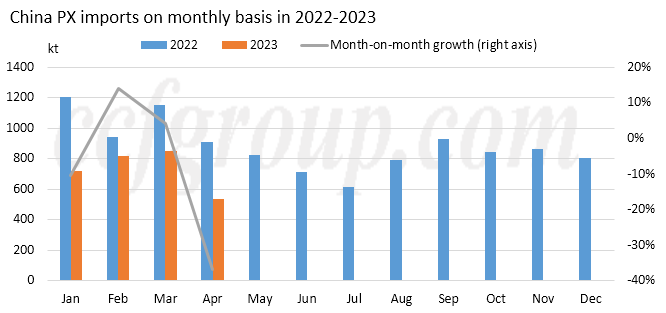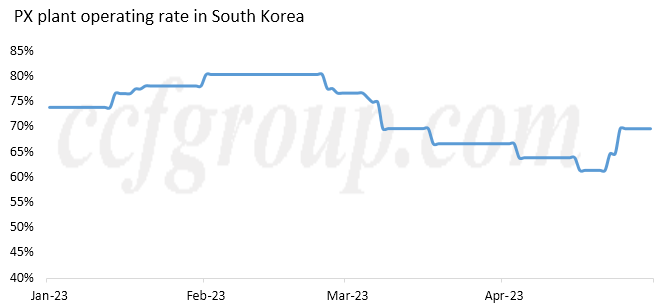Why China PX imports reduce sharply in Apr
According to China Customs data, the country imported 538.2kt of PX in Apr 2023, down 315kt or 36.9% from the month earlier, and hitting the new low on monthly basis since Oct 2012.

With the increasing sufficiency of China domestic materials due to capacity expansion, China's PX imports decreased in 2023 compared to the year earlier. The import volume increased on month during Jan-Mar, but then recorded a whopping drop in Apr. Then, where did the PX goods go?
1. Intensive turnarounds outside China
The figure below shows China PX imports in terms of different origins in Mar and Apr 2023.
| kt | Mar | Apr | Change |
| South Korea | 397.8 | 258.4 | -139.4 |
| Japan | 194.6 | 139.3 | -55.3 |
| Saudi Arabia | 20.8 | 0 | -20.8 |
| Brunei | 11.8 | 0 | -11.8 |
| Singapore | 23.8 | 15.7 | -8.1 |
| Vietnam | 10 | 0 | -10 |
| Taiwan | 119.7 | 101 | -18.7 |
| Kuwait | 33.9 | 4.8 | -29.1 |
| Malaysia | 40.5 | 19 | -21.5 |
| Total | 852.9 | 538.2 | -314.7 |
Except for Japan and Saudi Arabia, several PX plants in those countries underwent turnarounds in Mar or Apr, including South Korea's GS, Hengyi Brunei, Vietnam's NSRP, etc. Production cuts and plant maintenance resulted in reduction in their PX exports.
PX exports from South Korea to Chinese mainland recorded the biggest drop.

According to South Korea Customs, the exports to China have been falling since 2023, while according to China Customs, the imports of PX from South Korea increased during Jan-Mar. It was because that it would take time for the shipments to arrive and the goods to finish customs clearance, and thus some goods were calculated into next month in the calculation of China Customs' statistics. The statistics from South Korea Customs testifies to the continuous decline in PX exports.

In terms of plant operations, the average operating rate of PX plants in South Korea has moved lower since the beginning of the year, leading to reduced PX production and exports. Refineries adjusted down PX operating rates in the anticipation of rosy outlook for gasoline blending, and prepared to export more aromatics and refined oil to US. Due to several factors, China's PX imports from South Korea reduced sharply in Apr.
2. Delay of customs clearance
China Customs issued an announcement in Apr to strengthen the inspection and supervision on hazardous chemicals. After the announcement of the new regulation, the customs clearance for hazardous chemicals extended by 3 to 7 days, but inspection is usually only required for the first matching of the supplier and the unloading port. There will be no random inspections upon arrival at the port. Therefore, the sharp decline in imports in April compared to the previous month is also due to the random inspections brought about by the new Customs regulations, which prevented ships from unloading at the port on schedule.
In a conclusion, plant turnarounds and production cuts outside China, coupled with extended customs clearance time, has led to the sharp reduction of PX imports in Apr. With turnaround completing and plant operating rate rebounding, PX supply is expected to increase. In addition, after the first sampling inspection, customs clearance would be the same as before. The imports are expected to increase in May.
- Top keywords
- Cotton Price
- Cotton Futures Price
- Cotton Futures
- CZCE
- PTA Futures Price
- Chemical Fiber
- Polyester Prices
- Wool price
- PTA Futures
- Shengze Silk
- China
- Yarn Price
- price
- China Textile City
- Fibre Price
- Benzene Price
- Cotton
- Index
- Cotton Index
- PTA
- fabric price
- NYMEX
- Top 10
- textile industry
- Spot Cotton
- Cotton Yarn
- Polyester Price
- Futures
- PTA Price
- cotton yarn price

